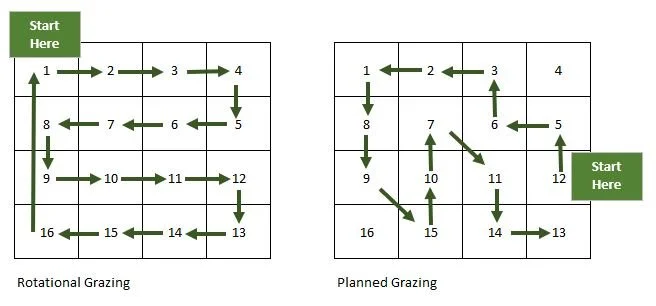The Difference Between Rotational Grazing & Holistic Planned Grazing
According to Merriam-Webster dictionary, the definition of rotational grazing is:
the shifting of livestock to different units of a pasture or range in regular sequence to permit the recovery and growth of the pasture plants after grazing
Merriam-Webster does not have a definition for holistic planned grazing, but Holistic Management International® defines it as:
at its core, grazing planning is about helping you identify key grazing priorities and strategies so you more effectively manage livestock in support of your holistic goal
Those of us within the holistic management community will explain planned grazing as:
“Getting the livestock at the right place, at the right time, for the right reasons.”
Both of these grazing methods accomplish a very important factor when using livestock to manage the land:
both minimize overgrazing
Overgrazing a grass plant is a function of time. It occurs when a severely bitten plant gets bitten severely again before the plant has had time to recover. This can happen at three different times:
When the plant is exposed to the animals for too many days and they are around to re-graze it while it’s trying to re-grow
When the animals are moved away from the plant but are allowed to return to the plant to soon
Immediately following dormancy when the plant is growing new leaf.
When a grass plant is grazed, it uses energy from its crown, stem bases or roots to reestablish growing leaf. Allowing the plant to be grazed before it has time to reestablish leaf growth means that the root base has shifted its energy from growing the roots to growing the leaves before the roots have had time to grow themselves. Repeated grazing before the grass is grown leaf will kill off the root base, eventually killing the grass plant.
what growth or lack of growth is happening above ground, is also happening below in the soil
The Main Difference
The main difference between rotational grazing and planned grazing is:
In rotational grazing you generally plan the grazing periods going forward for the grazing season.
With a grazing plan you are planning the recovery periods before you allow the livestock to graze again and planning is done backwards in critical periods.
In general, those using rotational grazing will follow a sequential pattern through the pastures or paddocks (subdivisions of a pasture), while those using planned grazing will have what might be an erratic pattern through the paddocks.
The erratic pattern in planned grazing is due to considerations, challenges, and complexities including:
differing plant growth rates
managing for ecosystem health rather than plant species
maximizing effectiveness of rain or snow
livestock performance
calving, lambing, kidding,
differing trampling and density levels (animal impact) to produce desired future landscape
watering
wildlife concerns
fitting crop rotations into a plan
Why Is Plant Recovery Important?
As a livestock producer, profit is larger if expenses (inputs) are less. So the more grass the producer has, the less expenses incurred by not having to purchase hay or supplemental feed. In order to have the grass to feed the livestock that will be the revenue source, we need to keep the roots alive and growing so that the grass plant keeps growing. Preventing overgrazing (as described above) to allow for a healthy and thriving root system should be every livestock producer’s goal!
The added benefit of allowing the grass plant to recover so that it has a healthy and thriving root system is a healthy soil environment that will allow for more effective water infiltration, more effective mineral cycle, which will lead to a diverse biological community, which will lead to an increase in grass plant diversity.
This increase in plant diversity will increase your forage, which in turn increases your carrying capacity (how many livestock you can feed).
The more livestock you can feed, with less expenses, the more profit being made!
Additionally, seasons affect grass growth. In the spring and early summer growth will be fast, so recovery will be shorter than later in the summer or fall when growth will be slower. The slower growth will require more recovery time.
The diversity of grass species means that growth rate isn’t going to be uniform across all pastures requiring differing pasture recovery based on pasture diversity.
Understanding the need for more or less recovery time will help you create a plan to maximize your grass production.
be a grass farmer so that you can be a livestock producer
The Benefit of Planned Grazing
Planning your grazing enables you to manage your livestock so that:
In the growing season, the land can produce the maximum amount of high quality forage on an increasing or sustained basis.
In the non-growing season, there is adequate standing forage for livestock (reducing the need to purchase hay).
Droughts can be dealt with effectively since you’ll know how much recovered forage you have available and can decide earlier than most if you need to reduce your livestock numbers to match the forage, or you might decide to purchase hay before prices are high due to increased demand during the drought.
The nutritional requirements of the livestock are met because you are allowing them to graze on grasses in their vegetative stage.
You can address landscape challenges or considerations with your grazing management as most properties have areas that need special attention: erosion, poor quality forage, dense woody species, prone to flooding, etc…
A grazing plan allows all in the operation to be on the same page, which is helpful when a crisis occurs or when a decision needs to be made
It becomes an annual historical record that can be used for bragging rights, but most especially it becomes a learning tool to understand your land better with each consecutive year while also improving your grazing skills and experience!
